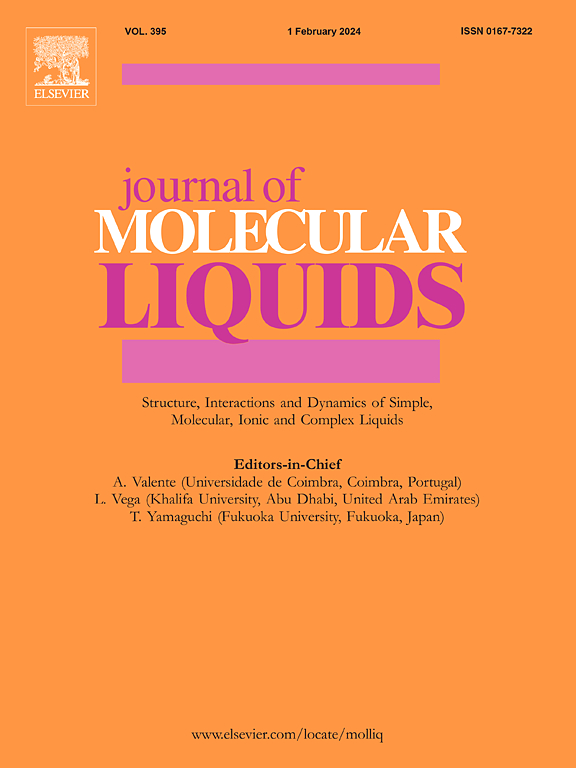亲水性一维纳米材料掺杂碳纳米管纸表面溶剂比蒸发特性研究
IF 5.3
2区 化学
Q2 CHEMISTRY, PHYSICAL
引用次数: 0
摘要
首先制备了掺杂亲水性铁绿石纳米管的非功能化碳纳米管基自支撑纸。利用扫描电镜和EDX对该复合材料进行了表征,并对其润湿和蒸发过程进行了全面研究。用质量(m)、电阻(R)和热像仪,在51℃平行测量丙酮、水、甲醇、乙醇和2-丙醇中5 μL液滴的润湿和汽化过程。质量损失曲线和蒸发曲线(由R测量确定)是汽化流体的特征。用Pearson相关系数法描述了液体的物理性质与由m和R测量确定的汽化参数特征之间的关系。这些关系对于潜在的分析应用是有希望的。第二步,研究了掺杂不同亲水性一维纳米材料的碳纳米管纸的溶剂比蒸发特性。比较了掺杂铁长石纳米管制备的层状结构巴克纸和掺杂针铁矿纳米线制备的混合结构巴克纸的性能。通过热成像、m和R测量的同时分析,描述了水在两种复合材料中的润湿和蒸发过程。亲水性一维纳米材料的存在改变了液体和掺杂材料的蒸发分布特征,表明了该方法的有效性。本文章由计算机程序翻译,如有差异,请以英文原文为准。
Solvent specific evaporation properties from the surface of carbon nanotube buckypapers doped by hydrophilic 1D nanomaterials
Non-functionalized carbon nanotube based self-supporting buckypaper doped by hydrophilic imogolite nanotube was prepared as a first step. This novel composite was characterized by SEM with EDX and was studied comprehensively to determine the wetting and evaporation processes. The wetting and vaporization of 5 μL drops from acetone, water, methanol, ethanol and 2-propanol were monitored at 51 °C in parallel by mass (m) and electrical resistance (R) measurements as well as by thermography. The mass loss curves and the evaporation profiles (determined from R measurements) are characteristic for the vaporizing fluids. Pearson correlation coefficients method was used to describe the relationship between the physical properties of the liquids and the parameters characteristic for the vaporization determined from the m and R measurements. These relationships are promising for a potential analytical application.
Solvent specific evaporation properties of carbon nanotube buckypapers doped by different hydrophilic 1D nanomaterials were characterized as a second step. The results were compared for the prepared layered structured buckypaper doped by imogolite nanotube and for a mixed structured buckypaper doped by goethite nanowire. Wetting and vaporization process of water was described for both composites by the simultaneous analysis of the thermography, m and R measurements. The presence of hydrophilic 1D nanomaterials changed the evaporation profiles characteristic for the liquids and for the doping materials, which shows the power of the used method.
求助全文
通过发布文献求助,成功后即可免费获取论文全文。
去求助
来源期刊

Journal of Molecular Liquids
化学-物理:原子、分子和化学物理
CiteScore
10.30
自引率
16.70%
发文量
2597
审稿时长
78 days
期刊介绍:
The journal includes papers in the following areas:
– Simple organic liquids and mixtures
– Ionic liquids
– Surfactant solutions (including micelles and vesicles) and liquid interfaces
– Colloidal solutions and nanoparticles
– Thermotropic and lyotropic liquid crystals
– Ferrofluids
– Water, aqueous solutions and other hydrogen-bonded liquids
– Lubricants, polymer solutions and melts
– Molten metals and salts
– Phase transitions and critical phenomena in liquids and confined fluids
– Self assembly in complex liquids.– Biomolecules in solution
The emphasis is on the molecular (or microscopic) understanding of particular liquids or liquid systems, especially concerning structure, dynamics and intermolecular forces. The experimental techniques used may include:
– Conventional spectroscopy (mid-IR and far-IR, Raman, NMR, etc.)
– Non-linear optics and time resolved spectroscopy (psec, fsec, asec, ISRS, etc.)
– Light scattering (Rayleigh, Brillouin, PCS, etc.)
– Dielectric relaxation
– X-ray and neutron scattering and diffraction.
Experimental studies, computer simulations (MD or MC) and analytical theory will be considered for publication; papers just reporting experimental results that do not contribute to the understanding of the fundamentals of molecular and ionic liquids will not be accepted. Only papers of a non-routine nature and advancing the field will be considered for publication.
 求助内容:
求助内容: 应助结果提醒方式:
应助结果提醒方式:


